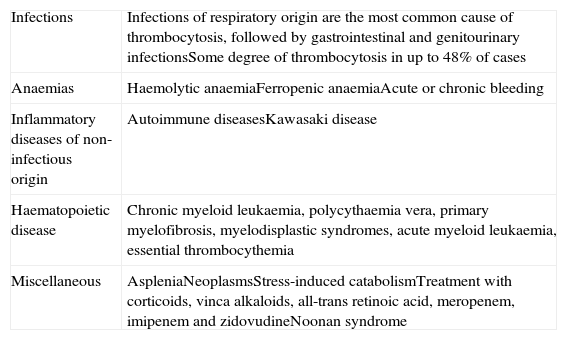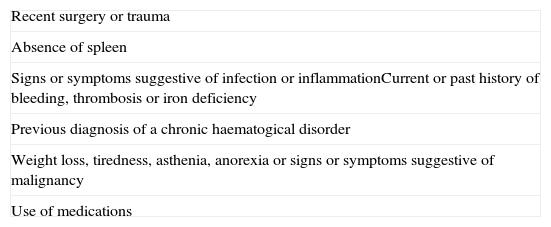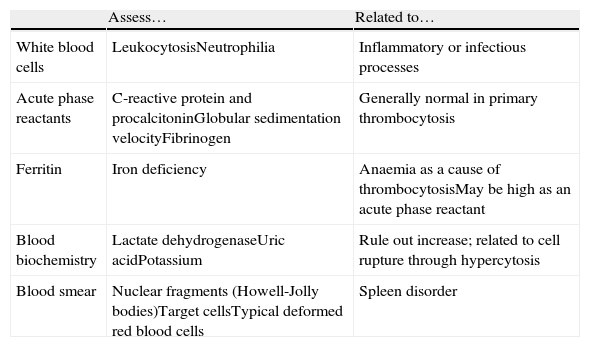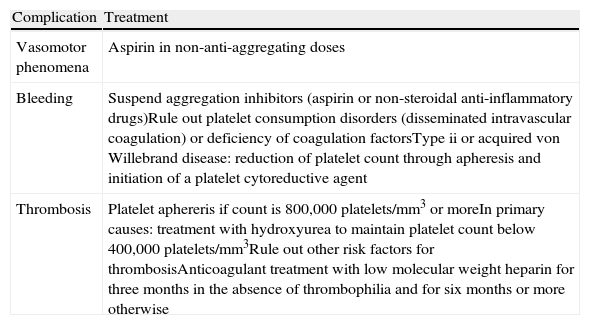Thrombocytosis is usually found by chance in children. Reactive or secondary thrombocytosis is the more common form, with infectious diseases being the most prevalent cause of it. Regarding the number of platelets there are four degrees of thrombocytosis; in its extreme degree the number of platelets exceeds 1,000,000/mm3. We describe a case of extreme reactive thrombocytosis in a healthy 6-year-old child. He required critical care admission for diagnosis and treatment (maximum number of platelets 7,283,000/mm3). We review the different causes of thrombocytosis in childhood, the differential diagnosis, and the available treatments in case of extreme thrombocytosis.
La trombocitosis es un hallazgo casual frecuente en pediatría. En niños, predominan las formas secundarias, siendo las infecciones su causa más prevalente. Se distinguen 4 grados de trombocitosis en función del número de plaquetas; en la forma extrema, se supera el 1.000.000/mm3. Se presenta un caso de trombocitosis extrema reactiva en un niño sano de 6 años, que requirió ingreso en cuidados intensivos para tratamiento y diagnóstico (cifra máxima de plaquetas de 7.283.000/mm3). Se revisan las diferentes causas de trombocitosis en la infancia, se describe el diagnóstico diferencial y se discute sobre los diferentes tratamientos disponibles ante un caso como el descrito.
Thrombocytosis is defined as a platelet count of more than two standard deviations higher than the upper limit of normal values (0.5×109/L).1,2 It is frequently found by chance in paediatrics. We present a case of extreme thrombocytosis in a healthy child. We describe the treatment, the differential diagnosis and the complications that occurred during its evolution.
Case studyAdmission to hospital: A 6-year-old boy attended the emergency department with fever for 12 days, cough, pain in the left side and asthenia. He had no personal or family history of interest. His general condition was fair, with oxygen saturation at 92–93%, tachypnea and left basal hypoventilation. Oxygen therapy was initiated through nasal cannula and the following were requested: (a) complete blood count (CBC): haemoglobin 9.1g/dL, white blood cells 32,850/mm3 (70% neutrophils) and platelets 5,301,000/mm3; (b) coagulation test: normal; (c) biochemistry: normal with C-reactive protein 9.1mg/dL and procalcitonin 0.36ng/mL; (d) chest X-ray: left basilar infiltrate and small associated effusion, and (e) blood culture.
With a presumptive diagnosis of pneumonia, he was admitted with oxygen therapy and intravenous treatment with amoxicillin/clavulanic acid (100mg/kg/day). The thrombocytosis was confirmed and considered to be possibly reactive.
Second day of hospitalisation: owing to an increase in pleural effusion, the patient was transferred. At the receiving hospital, following another chest scan, a watchful waiting approach was maintained, replacing the amoxicillin/clavulanic acid with intravenous cefotaxime (200mg/kg/day). In addition, a new CBC was performed and increased thrombocytosis was observed. The haemotology service was consulted and recommended carrying out further diagnostic tests, which were normal: (a) red blood cell morphology; (b) coagulation study with protein C and antithrombin iii; (c) autoimmunity: antinuclear antibodies, antineutrophil cytoplasmic antibodies and perinuclear antineutrophil antibodies, rheumatoid factor, serum immunoglobins, immune reconstitution, and (d) paraneoplastic phenomena: alpha-foetoprotein and chorionic gonadotropin.
Third day of hospitalisation: in a further ultrasound scan a new consolidation with pleural effusion was found in the right lung base. It was decided not to modify the treatment and to wait to see how the patient evolved.
Fifth day of hospitalisation: the patient had headache, more severe abdominal pain, a worsening of the right pleural effusion and increasing thrombocytosis. Treatment with aspirin (5mg/kg/day) was initiated, since the headache and abdominal pain were considered to be vasomotor phenomena. Clarithromycin (10mg/kg/day) was added to treat atypical pathogens. Further supplementary tests were also performed, and these too were negative: (a) blood tests for Chlamydophila pneumoniae, Chlamydophila psittaci, Chlamydia trachomatis, Coxiella burnetii, influenza A virus and influenza virus; (b) polymerase chain reaction (PCR) for adenovirus, Mycoplasma pneumoniae and respiratory syncytial virus; (c) Francisella tularensis antibodies, Legionella pneumophila serogroup 1, immunoglobin M (IgM) for Legionella pneumophila serogroup 1 and cytomegalovirus; (d) stool culture for adenovirus, rotavirus and faecal parasites; (e) hidden blood in stool, faecal calprotectin; (f) echocardiogram; (g) cranial computed tomography (CT) (normal), and (h) chest and abdomen CT (pleural effusion and consolidation without associated masses).
Sixth day of hospitalisation: the effusion was drained, yielding 820mL of exuded pleural fluid. An adenosine deaminase not indicative of tuberculosis was detected, the pneumococcal capsular antigen assay (BinaxNOW®) was negative, with no microorganisms in the Gram stain and negative Zielh-Neelsen stain. The pleural fluid analysis also included a culture of mycobacteria, fungi and bacteria, PCR for mycobacteria and an anatomical pathology examination.
At the same time as the pleural drainage, suction and biopsy of bone marrow were carried out together with flexible fibre optic bronchoscopy and bronchoalveolar lavage. In the bone marrow analysis a culture of mycobacteria, fungi and bacteria was requested together with PCR for cytomegalovirus and Epstein–Barr virus, in addition to JAK II and BCR-ABL hybrid genetic testing. The bronchoalveolar lavage analysis included an anatomical pathology study and a culture of mycobacteria, fungi and bacteria, immune reconstitution, PCR for enterovirus, rhinovirus, coronavirus, parainfluenza virus and influenza A, B and C viruses. All these tests were normal or negative.
Seventh and eighth days of hospitalisation: the pleural effusion, the fever and the abdominal pain decreased and the laboratory values normalised.
Ninth day of hospitalisation: in the laboratory tests performed before removing the drainage an increased platelet count was confirmed (7,283,000/mm3). It was decided to carry out a platelet apheresis to avoid a possible thrombosis. The right femoral vein was cannulated for this purpose and the platelet count was successfully reduced (2,252,000/mm3).
Tenth day of hospitalisation: the patient had oedema of the right lower extremity. Partial thrombosis of the right external iliac vein was detected and low molecular weight heparin (LMWH) was started (20mg/12h).
Twelfth day of hospitalisation up to discharge: the patient remained free of fever, headache, and abdominal pain. He showed a gradual reduction in platelet numbers and blood flow in the thrombosed area normalised. After 22 days he was discharged on treatment with aspirin (5mg/kg/day) and a prophylactic dose of LMWH. All the tests performed were negative or normal. A primary cause of thrombocytosis was ruled out, and it was considered to be related to the respiratory infection, with no aetiological diagnosis, which caused his hospitalisation.
He is currently in follow-up with the haematology service and his platelet count is normal without treatment.
DiscussionA chance finding of thrombocytosis is common in paediatrics. It must always be confirmed with a further CBC, since there are situations that can give rise to a false increase in platelet count (mixed cryoglobulinaemia or cellular lysis).1,4,5
Four degrees of thrombocytosis have been described: mild (500,000–700,000/mm3), moderate (700,000–900,000/mm3), severe (>900,000/mm3) and extreme or massive (>1,000,000/mm3).2,6 The aim must be to stabilise and treat the patient so as to determine subsequently whether the thrombocytosis is secondary (Table 1) or whether it is primary or clonal. In this respect, directed history taking (Table 2), proper interpretation of the diagnostic tests (Table 3) and a thorough physical examination (ruling out the presence of visceromegaly or adenopathy), as soon as the patient is admitted, help to guide the diagnosis.1,3,4
Causes of secondary thrombocytosis in paediatrics in order of prevalence.
| Infections | Infections of respiratory origin are the most common cause of thrombocytosis, followed by gastrointestinal and genitourinary infectionsSome degree of thrombocytosis in up to 48% of cases |
| Anaemias | Haemolytic anaemiaFerropenic anaemiaAcute or chronic bleeding |
| Inflammatory diseases of non-infectious origin | Autoimmune diseasesKawasaki disease |
| Haematopoietic disease | Chronic myeloid leukaemia, polycythaemia vera, primary myelofibrosis, myelodisplastic syndromes, acute myeloid leukaemia, essential thrombocythemia |
| Miscellaneous | AspleniaNeoplasmsStress-induced catabolismTreatment with corticoids, vinca alkaloids, all-trans retinoic acid, meropenem, imipenem and zidovudineNoonan syndrome |
Data of interest in the medical history of patients with thrombocytosis.
| Recent surgery or trauma |
| Absence of spleen |
| Signs or symptoms suggestive of infection or inflammationCurrent or past history of bleeding, thrombosis or iron deficiency |
| Previous diagnosis of a chronic haematogical disorder |
| Weight loss, tiredness, asthenia, anorexia or signs or symptoms suggestive of malignancy |
| Use of medications |
Interpretation of diagnostic tests in the emergency department.
| Assess… | Related to… | |
| White blood cells | LeukocytosisNeutrophilia | Inflammatory or infectious processes |
| Acute phase reactants | C-reactive protein and procalcitoninGlobular sedimentation velocityFibrinogen | Generally normal in primary thrombocytosis |
| Ferritin | Iron deficiency | Anaemia as a cause of thrombocytosisMay be high as an acute phase reactant |
| Blood biochemistry | Lactate dehydrogenaseUric acidPotassium | Rule out increase; related to cell rupture through hypercytosis |
| Blood smear | Nuclear fragments (Howell-Jolly bodies)Target cellsTypical deformed red blood cells | Spleen disorder |
The differential diagnosis must be made step-by-step, based on the patient's signs and symptoms.3 The diagnostic tests indicated will be those that provide useful information with an appropriate risk–benefit ratio. Bearing in mind the most prevalent causes of thrombocytosis in childhood, the following tests could be considered: (a) sterile body fluid cultures, blood tests and molecular biology techniques for viruses, bacteria and parasites; (b) rule out anaemia, of any cause, alterations in red blood cell morphology and blood clotting disorders; (c) consider autoimmune diseases; (d) perform imaging tests aimed at ruling out neoplasms, visceromegaly, adenopathy and Kawasaki disease (echocardiogram), and (e) assess the need to carry out suction and biopsy of bone marrow.1–4,6
Most patients will remain asymptomatic. Regardless of the cause of thrombocytosis, a high platelet count can be associated with vasomotor phenomena (headache, visual symptoms, nausea, chest pain, dysaesthesia, aphasia, dysarthria, vertigo, instability, shivering or erythromelalgia), thrombotic phenomena or haemorrhagic complications (Table 4).1,5 The vasomotor phenomena arise from intravascular platelet activation. Normally, reactive thrombocytosis does not entail a greater risk of thromboembolic events or haemorrhagic complications.7 On the other hand, in primary forms, this activation is symptomatic in up to 25–40% of patients.2,5 In our patient, the episodes of headache and abdominal pain may have been related to the extreme thrombocytosis.
Complications and treatment of thrombocytosis.
| Complication | Treatment |
| Vasomotor phenomena | Aspirin in non-anti-aggregating doses |
| Bleeding | Suspend aggregation inhibitors (aspirin or non-steroidal anti-inflammatory drugs)Rule out platelet consumption disorders (disseminated intravascular coagulation) or deficiency of coagulation factorsType ii or acquired von Willebrand disease: reduction of platelet count through apheresis and initiation of a platelet cytoreductive agent |
| Thrombosis | Platelet aphereris if count is 800,000 platelets/mm3 or moreIn primary causes: treatment with hydroxyurea to maintain platelet count below 400,000 platelets/mm3Rule out other risk factors for thrombosisAnticoagulant treatment with low molecular weight heparin for three months in the absence of thrombophilia and for six months or more otherwise |
Starting any treatment is controversial. Aspirin seems to be the most suitable drug. It suppresses thromboxane A2 production, lessening platelet activation but without reducing the risk of thrombosis. Nor is it clear that a prophylactic anticoagulant (LMWH) is indicated, even with extreme thrombocytosis counts in asymptomatic children.1,2,6 Initiating it must be considered on an individual basis in patients with other associated prothrombotic factors, such as thalassaemia, reduction in protein C or antithrombin iii or the presence of a central venous catheter.1 Cytoreductive therapy of any kind (drugs or platelet apheresis) is not recommended in patients with a low risk of thrombosis, but can be considered when the symptoms prove refractory despite appropriate treatment (Table 3).1,3 In our case, aspirin treatment produced a modest improvement in the patient's clinical condition, and platelet apheresis, given the large number of platelets and their state of activation, could have given rise to thrombosis of the external iliac vein.
To sum up, we here present a case of massive thrombocytosis secondary to a probable respiratory infection.6 The aim must be to treat the underlying infection and rule out a primary cause of thrombocytosis.3,4,7 Apart from antimicrobial drugs, the treatment will essentially consist of supportive measures. The appearance of vasomotor phenomena must be monitored to initiate aspirin treatment. In the event of complications such as bleeding or thrombosis, acute platelet apheresis will be carried out in order to achieve rapid platelet reduction.1
Conflicts of interestThe authors have no conflicts of interest to declare.
Please cite this article as: de Lama Caro-Patón G, García-Salido A, Iglesias-Bouzas MI, Guillén M, Cañedo-Villaroya E, Martínez-Romera I, et al. Trombocitosis extrema reactiva en un niño sano de 6 años. An Pediatr (Barc). 2014;81:318–321.







